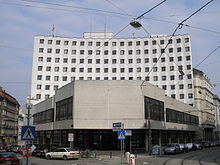Georg Lippert
Georg Lippert (born January 27, 1908 in Vienna ; † October 14, 1992 there ) was an Austrian architect .
Life
Lippert came from an educated middle class Hietzingen family with Tyrolean roots. In 1920 he spent a recreational stay in Sweden. 1919–1927 (Matura) he attended the Fichtnergasse high school , then the Vienna University of Technology , where he studied architecture. Georg Lippert received his engineering degree in 1931, but continued to study in Clemens Holzmeister's master class at the Academy of Fine Arts in Vienna until 1934 - not least because of the global economic crisis and the associated limited career opportunities for architects . The prehistorian Andreas Lippert is his son.
Professional creation

Lippert's rich professional work followed the zeitgeist to an exemplary extent. His first assignment (together with Kurt Klaudy , with whom Lippert had a studio community until 1945) was for the St.Hubertus-St.Christoph church in Vienna- Hietzing . 1936–1939 Lippert and Klaudy built the Kritschim hunting lodge for the Bulgarian Tsar Boris III. , 1939–1945 Industrial buildings and factory settlements for the Nazi regime. 1947 Lippert was a leader in the establishment of the wholesale community construction Hugo-Breitner-Hof in Vienna- Penzing involved.
It reached its greatest fame in the 1960s and 1970s. At that time Lippert was also long-time chairman of the advisory board for urban planning in terms of the Vienna building code . Among other things, Lippert built the Semperit Center in 1965 (instead of the Archduke Rainer Palace ), 1965–1967 the building of the Viennese representative office of the Hoffmann-La Roche company (instead of the Lanckoronski Palace ), and in 1973 the Winterthur House next to the Karlskirche in Vienna . Lippert was also involved in the new building of the Vienna Opernringhof (instead of the Heinrichshof ) and that of the (third) Vienna Dianabad , built the Haus des Buches (instead of the Vienna City Theater ) and continued urban development in Lausanne from 1966 to 1971 with the high-rise Champ d'asile complex Accents. Towards the end of his professional career, Lippert, one of Vienna's leading commercial architects, adapted to the postmodern zeitgeist and delivered a style copy of the building that had been destroyed in the war when a vacant lot on Schwarzenbergplatz in Vienna was closed . This building at Schwarzenbergplatz 3 and other buildings by Lippert (such as the house next to Karlskirche or the Raiffeisen high-rise near Vienna's Stadtpark) were in heated public discussion, but Lippert himself did not shy away from critical statements. In questions of Viennese urban planning , for example, he appeared as a rival to Roland Rainer's conception of a polycentric structure and was also verbally involved as a construction worker (federal state insurance, Raiffeisen-IBM complex) in the sense of a monocentric expansion of the city across the Danube Canal .
The humanistically educated architect who was interested in music was known or friends of personalities such as Clemens Holzmeister , Alvar Aalto , Erich Boltenstern and Oskar Kokoschka .
Realizations

- 1934–1935: with Kurt Klaudy: Parish Church of St. Hubertus and Christophorus , Vienna
- 1952–1960: Münzgrabenkirche Graz-Jakomini
- 1961–1965: with Otto Mayr: Semperit Center (now the headquarters of the Austrian Chamber of Commerce ), Vienna- Wieden (conversion 1983, 2008)
- 1962–1963: Parish Church of St. Francis von Sales , Vienna, Per-Albin-Hansson-Siedlung Nord
- 1969–1970: Parish Church of St. Nicholas, Pernitz (Lower Austria)
- 1975–1978: Austrian Airlines office and operations building, Vienna, Fontanastraße (demolished in 2012)
- 1981–1983: with Willibald Zemler: Innbrücke , Innsbruck
literature
- Georg Lippert: Buildings - Buildings. Herder, Vienna 1983
- Dieter Klein , Martin Kupf , Robert Schediwy : Stadtbildverluste Wien. Vienna 2005
Web links
- Literature by and about Georg Lippert in the catalog of the German National Library
- Georg Lippert. In: Architects Lexicon Vienna 1770–1945. Published by the Architekturzentrum Wien . Vienna 2007.
- Georg Lippert at alt-hietzinger.at
Individual evidence
- ^ Lippert, Andreas in the Österreich-Lexikon
- ↑ On the discussions about the latter building cf. Weekly press (from October 11, 1972)
| personal data | |
|---|---|
| SURNAME | Lippert, Georg |
| BRIEF DESCRIPTION | Austrian architect |
| DATE OF BIRTH | January 27, 1908 |
| PLACE OF BIRTH | Vienna |
| DATE OF DEATH | October 14, 1992 |
| Place of death | Vienna |
